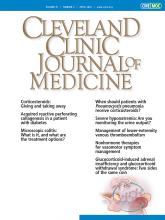Article Figures & Data
Tables
Contraindications Pertinent considerations Prior history of coronary heart disease, stroke, myocardial infarction, or unprovoked venous thromboembolism or inherited high risk of thromboembolic disease, or significantly high risk for cardiovascular disease Relative contraindication: hormone therapy can be considered on a case-by-case basis Unexplained vaginal bleeding Relative contraindication: unexplained vaginal bleeding should be evaluated before hormone therapy is considered End-stage liver disease Relative contraindication: hormone therapy can be considered on a case-by-case basis Prior history of estrogen-receptor-positive cancer Absolute contraindication - TABLE 2
Nonhormone pharmacologic agents currently available for management of vasomotor symptoms
Class Medication Dosing for VMSa Clinical pearls SSRIs Paroxetine salt10,11,23,24
Paroxetine10,11,23,24
Fluoxetine11,23,24,26
Sertraline11,23,24,27
Citalopram10,11,23,24
Escitalopram10,11,23–257.5 mg daily at bedtime
10–25 mg daily
10–30 mg daily
25–100 mg daily
10–20 mg daily
10–20 mg dailyPotent cytochrome P450 CYP2D6 enzyme inhibitors; do not use with tamoxifen as SSRIs reduce tamoxifen bioavailability and efficacy
Paroxetine mesylate 7.5 mg was the first and only US Food and Drug Administration–approved nonhormone medication for moderate to severe menopausal VMS until the development of neurokinin-receptor antagonists
Fluoxetine and sertraline are not recommended for VMS reduction owing to inconsistent data regarding efficacy in hot flash frequency and severity reduction
Sertraline has a moderate effect on the CYP2D6 enzyme
Citalopram and escitalopram may cause QT prolongationSNRIs Desvenlafaxine10,11,23,24
Venlafaxine10,11,23,24
Duloxetine11,23,25100–150 mg daily
37.5–75 mg daily
30–60 mg dailySNRIs may increase blood pressure, use with caution in patients with hypertension
Venlafaxine is the most well studied SNRI in combination with tamoxifen
Duloxetine has a moderate effect on the CYP2D6 enzymeGabapentinoid Gabapentin10,11,28–31 300–2,400 mg daily (divided doses) Consider for patients with a history of neuropathic pain or sleep concerns
Consider nightly dosing (starting dose of 100–300 mg at bedtime) to minimize any adverse effects of daytime fatigueAntimuscarinic Oxybutynin11,24,31,32 2.5–5 mg twice a day (immediate release), up to 15 mg/day (extended release) Consider for patients with concurrent overactive bladder or hyperhidrosis
Use caution in older adults (≥ 65 years); avoid altogether in patients ≥ 65 years taking concomitant anticholinergic medicationsAlpha-2 adrenergic agonist Clonidine11,32,33 0.05–0.1 mg once or twice a day Consider for patients with hypertension, especially if improved blood pressure control is desired
Avoid in older adult patients (≥ 65 years)
Less often used and no longer recommended by the Menopause Society owing to modest efficacy vs placebo and side-effect profileNeurokinin-receptor antagonist Fezolinetant11,34,35 45 mg daily Exercise caution in patients taking concomitant CYP1A2 enzyme inhibitors, which increase potency of fezolinetant
Check transaminase levels at baseline, 3 months, 6 months, and 9 months↵a Based on clinical efficacy demonstrated in randomized controlled trials and the Menopause Society recommendations.10,11
SNRI = serotonin-norepinephrine reuptake inhibitor; SSRI = selective serotonin reuptake inhibitors; VMS = vasomotor symptoms






